| |
 |
|
Physician
Requirements Projections
The
baseline projections suggest that between 2005 and 2020
overall requirements for physicians engaged primarily in
patient care increase 22 percent, from approximately 713,800
to 921,500 (Exhibits 24, 26, and 27). In percentage terms,
growth is lower for primary care (20 percent) than for non-primary
care (23 percent). If we assume that requirements for physicians
engaged primarily in non-patient care activities (e.g.,
administration, teaching, and research) remain relatively
constant at approximately 6 percent of total physicians,
then total requirements for physicians will increase from
about 756,100 to 976,000 during this period.
[14]
On
a per capita basis, demand for physicians is increasing
as a result of an aging population (Exhibits 25, 28, and
29). For example, under the baseline scenario, requirements
for physicians engaged in patient care increases from approximately
259 to 281 (8 percent) per 100,000 population between 2005
and 2020. In percentage terms, the increase is greater for
non-primary care (9 percent) than for primary care (7 percent).
Projected
growth in requirements between 2005 and 2020 varies substantially
by specialty (Exhibit 30). Between 2005 and 2020, specialties
with the highest percentage growth are cardiology (33 percent)
and urology (30 percent). Specialties with the lowest percentage
growth are pediatrics (9 percent) and obstetrics/gynecology
(10 percent).
Exhibit
24. Baseline Projections of Physician Requirements
| |
Patient Care |
Non-patient Care |
Total |
| Year |
Primary Care |
Non-primary
Care |
Total |
| 2000* |
267,100 |
446,800 |
713,800 |
42,200 |
756,100 |
| 2005 |
281,800 |
475,500 |
757,300 |
44,800 |
802,100 |
| 2010 |
297,500 |
507,900 |
805,400 |
47,700 |
853,100 |
| 2015 |
316,300 |
544,300 |
860,600 |
50,900 |
911,500 |
| 2020 |
337,400 |
584,100 |
921,500 |
54,500 |
976,000 |
| Change:
2005–2020 |
20% |
23% |
22% |
22% |
22% |
* Base
year assumes that physician supply and demand are balanced.
Exhibit
25. Baseline Physician Requirements per 100,000 Population
| |
Patient Care |
Non-patient Care |
Total |
| Year |
Primary Care |
Non-primary
Care |
Total |
| 2000* |
95 |
158 |
253 |
15 |
268 |
| 2005 |
95 |
161 |
256 |
15 |
271 |
| 2010 |
96 |
164 |
261 |
15 |
276 |
| 2015 |
98 |
169 |
267 |
16 |
283 |
| 2020 |
100 |
174 |
274 |
16 |
291 |
| Change
2005–2020 |
5% |
8% |
7% |
7% |
7% |
* Base
year assumes that physician supply and demand are balanced.
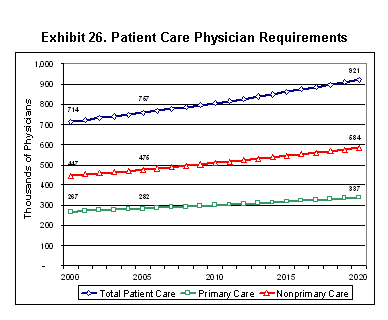 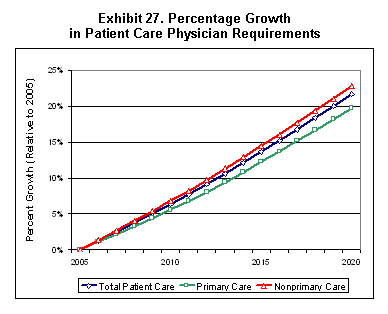
[D]
[D]
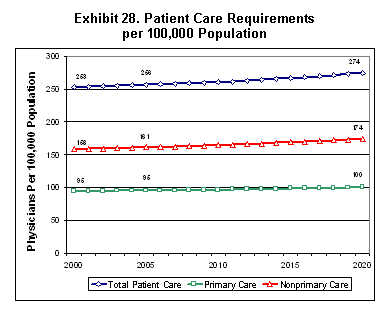 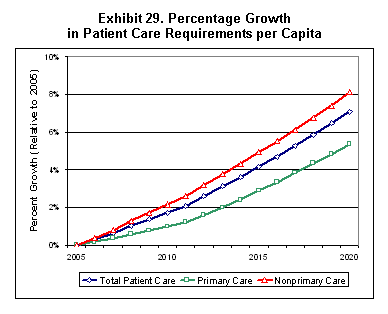
[D]
[D]
Exhibit
30. Physician Requirements by Medical Specialty: Baseline
Projections
| |
Base Year |
Projected |
|
Specialty |
2000 |
2005 |
2010 |
2015 |
2020 |
Percent Change
from 2005–2020 |
|
Total |
756,100 |
802,100 |
853,100 |
911,500 |
976,000 |
22% |
|
Total Non-patient Care |
42,200 |
44,800 |
47,700 |
50,900 |
54,500 |
22% |
|
Total Patient Care |
713,800 |
757,300 |
805,400 |
860,600 |
921,500 |
22% |
|
Primary Care |
267,100 |
281,800 |
297,500 |
316,300 |
337,400 |
20% |
|
General Family Practice |
107,700 |
113,900 |
120,600 |
127,900 |
135,900 |
19% |
|
General Internal Medicine |
107,500 |
115,000 |
123,400 |
132,900 |
143,500 |
25% |
|
Pediatrics |
51,900 |
52,900 |
53,500 |
55,500 |
57,900 |
9% |
|
Non-primary Care |
446,800 |
475,500 |
507,900 |
544,300 |
584,100 |
23% |
|
Medical Specialties |
86,400 |
93,000 |
100,700 |
109,800 |
119,800 |
29% |
|
Cardiology |
20,600 |
22,200 |
24,200 |
26,700 |
29,600 |
33% |
|
Other Internal Medicine |
65,900 |
70,800 |
76,500 |
83,100 |
90,200 |
27% |
|
Surgical Specialties |
159,400 |
169,000 |
179,900 |
192,000 |
205,100 |
21% |
|
General Surgery |
39,100 |
41,700 |
44,800 |
48,400 |
52,200 |
25% |
|
Obstetrics/Gynecology |
41,500 |
43,100 |
44,800 |
46,000 |
47,200 |
10% |
|
Ophthalmology |
18,400 |
19,700 |
21,200 |
23,100 |
25,200 |
28% |
|
Orthopedic Surgery |
24,100 |
25,600 |
27,300 |
29,300 |
31,600 |
23% |
|
Other Surgery |
16,200 |
17,400 |
18,800 |
20,300 |
22,000 |
26% |
|
Otolaryngology |
9,800 |
10,300 |
11,000 |
11,600 |
12,400 |
20% |
|
Urology |
10,400 |
11,100 |
12,000 |
13,200 |
14,400 |
30% |
|
Other Specialties |
200,900 |
213,500 |
227,300 |
242,500 |
259,200 |
21% |
|
Anesthesiology |
37,800 |
40,200 |
43,000 |
46,500 |
50,400 |
25% |
|
Emergency Medicine |
26,300 |
27,600 |
28,900 |
30,300 |
31,800 |
15% |
|
Pathology |
17,200 |
18,400 |
19,800 |
21,200 |
22,600 |
23% |
|
Psychiatry |
38,300 |
40,700 |
43,000 |
45,200 |
47,400 |
16% |
|
Radiology |
30,900 |
32,900 |
35,200 |
37,900 |
41,100 |
25% |
|
Other Specialties |
50,400 |
53,700 |
57,400 |
61,400 |
65,800 |
23% |
Note:
Due to rounding, sum of subtotals may not equal totals.
The
baseline projections assume that patterns of healthcare
use and delivery of care remain unchanged over the projection
horizon and that changing demographics are the primary driver
of changes in physician requirements. To better understand
the implications of possible changes in utilization and
delivery patterns we project physician requirements from
2005 to 2020 under alternative scenarios (Exhibits 31 and
32).
- Growing
role of NPCs. This scenario assumes that (1)
the number of active NPCs will increase 60 percent between
2005 and 2020; (2) all NPCs that are trained will become
employed and will provide services that otherwise would
have been provided by physicians; and (3) on average each
NPC will provide 40 percent of the work currently provided
by a physician. Under this scenario, by 2020 physician
requirements would be approximately 90,000 physicians
less than the baseline projections. NPCs will have a disproportionate
impact by specialty, with NPCs having a greater impact
on reducing demand for generalists.
- Economic
growth. This scenario assumes that economic growth
will allow the Nation to afford a higher-quality healthcare
system. This new healthcare system will require more physicians
and, in particular, more specialists. Physician requirements
are projected under the assumption that per capita income
will grow by 2 percent annually, and that demand for some
specialties is relatively insensitive (elasticity=0.25)
[15]
, modestly sensitive (elasticity=0.50)
[16],
or more sensitive (elasticity=0.75)
[17]
to economic growth. The latter scenario produces the highest
projections, with requirements growing to 1.1 million
physicians in 2020 (136,000 higher than the baseline projection).
Projections by specialty are provided in Exhibit 32.
- Physician
productivity increase. Requirements are projected
under the assumption that physician productivity will
increase 1 percent per year (i.e., each physician can
see 1 percent more patients per year through improved
use of staff and technology). Projected physician requirements
remain relatively constant through 2020 under this scenario,
with the projection suggesting 137,000 fewer physicians
than projected under the baseline scenario in 2020.
- Economic
growth offset by physician productivity increase.
Combining the previous two scenarios, the growth in demand
for physician services due to economic growth is offset
by the increased productivity of physicians resulting
in projected requirements of 956,000 in 2020 (20,000 fewer
than under the baseline scenario).
Exhibit
31. Alternative Requirements Projections
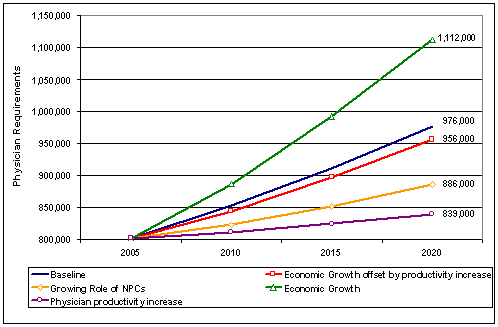 [D]
[D]
Exhibit
32. Physician Requirements by Medical Specialty: High Economic
Growth Series
| Specialty |
2005 |
2010 |
2015 |
2020 |
Percent
Change 2005 to 2020 |
| Total |
802,000 |
887,000 |
992,000 |
1,112,000 |
38% |
| Total
Non-Patient Care |
45,000 |
48,000 |
51,000 |
55,000 |
22% |
| Total
Patient Care |
757,000 |
839,000 |
941,000 |
1,057,000 |
39% |
| Primary
Care |
282,000 |
306,000 |
334,000 |
367,000 |
30% |
| General
Family Practice |
114,000 |
124,000 |
135,000 |
148,000 |
30% |
| General
Internal Medicine |
115,000 |
127,000 |
140,000 |
156,000 |
36% |
| Pediatrics |
53,000 |
55,000 |
59,000 |
63,000 |
19% |
| Nonprimary
Care |
476,000 |
533,000 |
607,000 |
690,000 |
45% |
| Medical
Specialties |
93,000 |
105,000 |
122,000 |
141,000 |
52% |
| Cardiology |
22,000 |
25,000 |
30,000 |
35,000 |
59% |
| Other
Internal Medicine |
71,000 |
80,000 |
92,000 |
106,000 |
49% |
| Surgical
Specialties |
169,000 |
189,000 |
215,000 |
243,000 |
44% |
| General
Surgery |
42,000 |
47,000 |
54,000 |
61,000 |
45% |
| OB/GYN |
43,000 |
46,000 |
49,000 |
51,000 |
19% |
| Ophthalmology |
20,000 |
23,000 |
27,000 |
32,000 |
60% |
| Orthopedic
Surgery |
26,000 |
29,000 |
34,000 |
40,000 |
54% |
| Other
Surgery |
17,000 |
20,000 |
24,000 |
28,000 |
65% |
| Otolaryngology |
10,000 |
12,000 |
13,000 |
15,000 |
50% |
| Urology |
11,000 |
12,000 |
14,000 |
16,000 |
45% |
| Other
Specialties |
214,000 |
239,000 |
270,000 |
306,000 |
43% |
| Anesthesiology |
40,000 |
45,000 |
52,000 |
59,000 |
48% |
| Emergency
Medicine |
28,000 |
30,000 |
32,000 |
35,000 |
25% |
| Pathology |
18,000 |
21,000 |
23,000 |
27,000 |
50% |
| Psychiatry |
41,000 |
46,000 |
53,000 |
60,000 |
46% |
| Radiology |
33,000 |
37,000 |
42,000 |
48,000 |
45% |
| Other
Specialties |
54,000 |
60,000 |
68,000 |
77,000 |
43% |
Note: Due to
rounding, sum of subtotals may not equal totals. |